If you’re looking to save some money for your company by buying used dump trucks for your fleet, you’ll want to make sure you’re thoroughly inspecting your potential purchase. While it’s important to thoroughly inspect any used vehicle you buy, it’s even more important when it comes to dump trucks. If not, you could very well end up with a dump truck that’s been overworked, and is ready to fall apart. Why? Simply because the dump truck you’re looking at his lived the entirety of its life (and will continue to do so) on job sites. It’s experienced far more wear and tear than your average daily driver.
Do your due diligence because a few used dump trucks, in good condition, can be a great way to fill out your fleet.
Check the Body
The first thing you see when shopping for any car is the body and that should be the first thing you inspect.
Start with the dump body, since that’s the most prominent part of a dump truck. Check the siding for holes or bad rust spots, along with the tailgate. Make sure the hinges and handle works properly, and don’t be afraid to crawl up and look at the siding from the inside as well. Pay close attention to the floor for puncture damage or corrosion via rust – especially up near the headboard, and where the side meets the floor.
You’ll also want to note if the dump body is made from aluminum or steel. Steel is heavier, and much more durable than aluminum. However, this will add more weight than an aluminum dump body. Meaning fuel economy and speed (which isn’t really a priority) will be impacted. On the other hand, aluminum won’t be able to handle rubble, rocks, or other hazardous objects that would turn an aluminum dump body into Swiss cheese. If the loader your company uses will just deal with dirt, then aluminum is probably fine.
Next, check the cab itself. Look for any major rust spots (like you would on any vehicle), and make sure there’s nothing severely wrong with it.
Finally, check the tires. Look for uneven tread wear. Just like on a sedan or smaller vehicle, this is a sign of an alignment issue.
Check the Frame
After you’ve completed the inspection of the body, make sure to look at the frame. Check for any rust problems, but also look at the frame rails. Pay attention to any sagging or bowing bends. If a frame rail is sagging, this could be a sign that the truck was carrying way over its payload (too much weight). Since the frame rail is compromising the structural integrity, this will be a costly fix. If you see a frame rail bowing upward, it could mean the operator drove the truck with a loaded and upright box frequently.
Make sure to look at the frame from underneath the truck, along with lifting the dump body and looking at it from the top.
Check the Axles
While you’re under there checking the frame rails for rust or bends, also take a look at the axles. Since they’re responsible for supporting a heavy load (just like the frame) you’ll want to make sure there’s no structural damage done to them. Also, it’s a good to look for any push axles or tag axles – both help the truck spread that heavy load across multiple axles, meeting various state regulations.
This is important if you’re operating in a state that is strict about weight regulations.
Not Mechanically Inclined? Opt for an Inspection.
If you aren’t mechanically inclined, make sure to bring your mechanic along. Or, simply get it inspected.
Either way, you want to make sure you’re doing your due diligence, and thoroughly inspecting your prospective used dump truck. If not, you could end up with some costly repairs and a broken-down vehicle.



